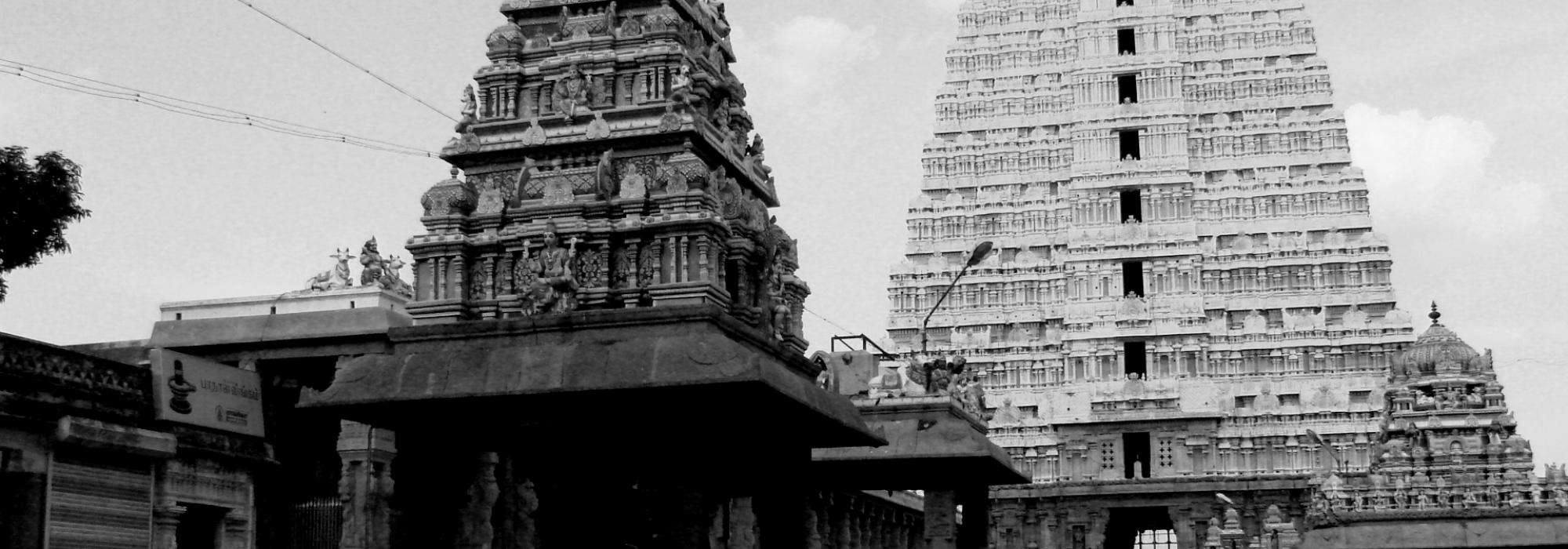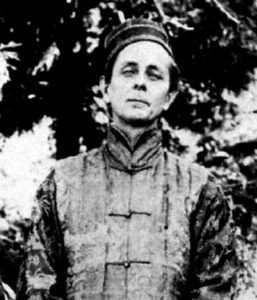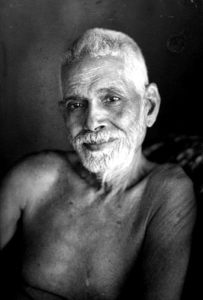Ramana Maharshi (30 December 1879 – 14 April 1950) was an Indian sage. Born Venkataraman Iyer, he left home in 1896 at the age of 16 and landed at Thiruvannamalai. After years of deep tapas, he attained a state of jivanmukti (release from the bindings of the cycle of karma even when alive). An open-minded yet devout person, Ramana primarily focused on Self-inquiry as a means to exhaust ignorance and become one with the atman. Although he mostly remained silent, on occasion, he had discussions with visitors and disciples.
On 24th January 1935, Mr. W. Y. Evans-Wentz, an English research scholar from Oxford visited Thiruvannamali and brought with him a letter of introduction from Paul Brunton. Evans-Wentz was accustomed to the Indian ways of living, having visited this country several times. Having learned Tibetan, he helped in the translation of the Book of the Dead and the Life of Milarepa, the greatest of Tibetan yogis, and a third book on the Tibetan Secret Doctrines.
A few days later, on the 30th of January, Evans-Wentz had a discussion with the Maharishi.
Evans-Wentz: Is solitude necessary for a jnani?
Ramana Maharishi: Solitude is in the mind of man. One might be in the thick of the world and maintain serenity of mind; such a one is in solitude. Another may stay in a forest, but still be unable to control his mind. He cannot be said to be in solitude. Solitude is a function of the mind. A man attached to desire cannot get solitude wherever he may be; a detached man is always in solitude.
EW: So then, one might be engaged in work and be free from desire and keep up solitude. Is it so?
RM: Yes. Work performed with attachment is a shackle, whereas work performed with detachment does not affect the doer. He is, even while working, in solitude.
EW: They say that there are many saints in Tibet who remain in solitude and are still very helpful to the world. How can it be?
RM: It can be so. Realisation of the Self is the greatest help that can be rendered to humanity. Therefore, the saints are said to be helpful, though they remain in forests. But it should not be forgotten that solitude is not in forests only. It can be had even in towns, in the thick of worldly occupations.
EW: It is not necessary that the saints should mix with people and be helpful to them?
RM: The Self alone is the Reality; the world and the rest of it are not. The realised being does not see the world as different from himself.
EW: Thus then, the saint’s realisation leads to the uplift of humanity without the latter being aware of it. Is it so?
RM: Yes. The help is imperceptible but is still there. A saint helps the whole of humanity, unknown to the latter.
EW: Would it not be better if he mixed with others?
RM: There are no others to mix with. The Self is the one and only Reality.
EW: If there be a hundred Self-realised men will it not be to the greater benefit of the world?
RM: When you say ‘Self’ you refer to the unlimited, but when you add ‘men’ to it, you limit the meaning. There is only one Infinite Self.
EW: Yes, yes, I see! Sri Krishna has said in the Gita that work must be performed without attachment and such work is better than idleness. Is it Karma Yoga?
RM: What is said is given out to suit the temperament of the hearers.
EW: In Europe it is not understood by the people that a man in solitude can be helpful. They imagine that men working in the world can alone be useful. When will this confusion cease? Will the European mind continue wading in the morass or will it realise the truth?
RM: Never mind Europe or America. Where are they except in your mind? Realise your Self and then all is realised. If you dream and see several men, and then wake up and recall your dream, do you try to ascertain if the persons of your dream creation are also awake?
EW: What does Maharshi think of the theory of universal illusion (Maya)?
RM: What is Maya? It is only Reality.
EW: Is not Maya illusion?
RM: Maya is used to signify the manifestations of the Reality. Thus Maya is only Reality.
EW: Some say that Sri Sankaracharya was only intellectual and not realised. Is it so?
RM: Why worry about Sankaracharya? Realise your own Self. Others can take care of themselves.
EW: Jesus Christ cured people of their diseases. Is that only an occult power (siddhi)?
RM: Was Jesus aware at the time that he was curing men of their diseases? He could not have been conscious of his powers. There is a story related as follows: Jesus had once cured a man of his blindness. The man turned wicked, in course of time. Meeting him after some years, Jesus observed his wickedness and asked him why he was so. He replied saying that, when he was blind, he could not commit any sin. But after Jesus had cured him of blindness he grew wicked and Jesus was responsible for his wickedness.
EW: Was not Jesus a Perfected Being possessing occult powers (siddhi)?
RM: He could not have been aware of his powers (siddhis).
EW: Is it not good to acquire them, such as telepathy, etc.?
RM: Telepathy or radio enables one to see and hear from afar. They are all the same, hearing and seeing. Whether one hears from near or far does not make any difference in hearing. The fundamental factor is the hearer, the subject. Without the hearer or the seer, there can be no hearing or seeing. The latter are the functions of the mind. The occult powers (siddhis) are therefore only in the mind. They are not natural to the Self. That which is not natural, but acquired, cannot be permanent, and is not worth striving for. They denote extended powers. A man is possessed of limited powers and is miserable; he wants to expand his powers so that he may be happy. But consider if it will be so; if with limited perceptions one is miserable, with extended perceptions the misery must increase proportionately. Occult powers will not bring happiness to anyone, but will make him all the more miserable! Moreover what are these powers for? The would-be occultist (siddha) desires to display the siddhis so that others may appreciate him. He seeks appreciation, and if it is not forthcoming he will not be happy. There must be others to appreciate him. He may even find another possessor of higher powers. That will cause jealousy and breed unhappiness. The higher occultist (siddha) may meet a still higher siddha and so on until there will come one who will blow up everything in a trice. Such is the highest adept (siddha) and He is God or the Self. Which is the real power? Is it to increase prosperity or bring about peace? That which results in peace is the highest perfection (siddhi).
EW: But common people in Europe and America would not appreciate such an attitude and would desire a display of powers and instructions by lectures, etc.
RM: Lectures may entertain individuals for a few hours without improving them. Silence on the other hand is permanent and benefits the whole of humanity.
EW: But silence is not understood.
RM: It does not matter. By silence, eloquence is meant. Oral lectures are not so eloquent as silence. The Silence is unceasing eloquence. The Primal Master, Dakshinamurti, is the ideal. He taught his rishi disciples by silence.
EW: But then there were disciples for Him. It was all right. Now it is different. They must be sought after and helped.
RM: That is a sign of ignorance. The power which created you has created the world. If it can take care of you, it can similarly take care of the world also.
EW: What does Bhagavan think of the “lost soul” mentioned by Jesus Christ?
RM: Think what there is to be lost. Is there anything to lose? What matters is only that which is natural. Such must be eternal and cannot be experienced. That which is born must die; that which is acquired must be lost. Were you born? You are ever existent. The Self can never be lost.
EW: Buddha advises the eight-fold path as being the best so that none might be lost.
RM: Yes. Such is called Raja Yoga by the Hindus.
EW: Is yoga advised for a spiritual aspirant?
RM: Yoga helps control of mind.
EW: But does it not lead to occult powers (siddhis) which are said to be dangerous?
RM: But you qualified your question by the words “a spiritual aspirant”. You did not mean a seeker of powers (siddhis)?
Reference
Talks with Sri Ramana Maharshi. Tiruvannamalai: Sri Ramanasramam, 2006. pp. 15-19 (Talk 20)

















































